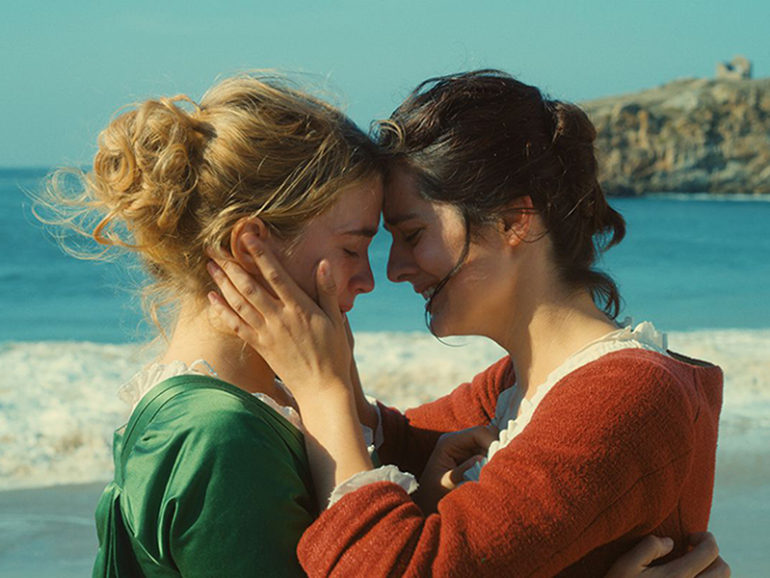Hannah explores the recent progression of sex between queer womxn in film

Getting sex right in cinema is hard enough. Making sweaty sex scenes between characters feel authentic and familiar is a challenge for any filmmaker – getting lesbian sex, and all of its complexities and wonders, right is a task that few have succeeded in.
As films made by queer women, for queer women, now begin to wade into popular cinema (as can be seen with the recent critical and commercial success of Céline Sciamma’s 19th century lesbian romance – Portrait of a Lady on Fire), it feels necessary to discuss the development of the way our sex lives are explored onscreen.
For a long time, the Palme d’Or winning Blue Is the Warmest Colour was regarded – mostly by heterosexual critics – as the benchmark for the portrayal of lesbian sex scenes in cinema. These scenes, while initially praised by audiences, have been unpacked over recent years by actual queer people as having mostly served as the projection of male fantasies about what womxn do in the bedroom, rather than having broken any actual ground.
Gratuity and melodrama
One scene, for example, is particularly gratuitous in that it lasts for almost seven minutes and consists of exaggerated sex and scissoring between the film’s two leading characters – sex that, quite clearly, exists for the pleasure of male viewers rather than for the appreciation and enjoyment of actual LGBTQ+ womxn.
Since the release of Blue is The Warmest Colour in 2013, however, the depiction of sex between queer womxn in film has progressed, even if it is still not quite where it should be with regards to widespread representation. Last year, in fact, there were two films that treated lesbian sex in exactly the way that it should be treated – on par with the way in which heterosexual sex is portrayed in cinema, with touches of authenticity, tenderness, and respect.
Realistic and raw
Disobedience, 2019’s adaptation of Naomi Alderman’s story of a languorous love affair that forms between two womxn in an Orthodox Jewish community in the pockets of North London – received high acclaim for the scene in which Ronit (Rachel Weisz) and Esti (Rachel McAdams) consummate their relationship in the safety of a hotel room removed from their repressive surroundings.
Here, the womxn’s passion for one another is left unsanitized and, yet, characterised by a sense of softness and an intimate knowing of each other. One moment that got people talking is the insistence in which Esti gently gestures for Ronit to spit directly into her mouth – to share herself with her in such a way that nothing is left unexplored between them.
This moment is void of any kind of sensationalism or sense of exploitation. Rather, it is arguably one of the purest acts of sexuality ever shown in queer cinema – two womxn are framed so deeply in love that they have to exchange even their salivia with each other to physically express the strength of their bond. The sex scene in Disobedience is coloured by both delicateness and rawness, where love coincides with a desire that has been repressed for years and results in a quiet implosion.
The other film last year that provided young LGBTQ+ womxn with an accurate, and rather sweet, depiction of lesbian sex was Olivia Wilde’s raucous debut Booksmart, in which two formerly gawky teenage girls embark on one wild night of exploration. As the film’s central pair, Amy and Molly, finally arrive at the graduation party they spend the first half of the movie searching for, Amy finds herself indulging – at last – in her burgeoning sexuality.
After an unexpected encounter with a girl that she previously believed to have hated her, Amy finally gets to dive into her untapped desires in a scene that blends the embarrassing nature of first times together with the tentativeness of the first tangible brush with queerness. In sharp contrast with Disobedience, the sex scene shared between two young womxn in Booksmart is not so much about the exploration of suppressed passion but, rather, the messiness of our first sexual experiences.
The depiction of lesbian sex in Booksmart feels special in that it is treated in much the same way that first times between heterosexual partners are – rather than feeling exaggerated, this moment in Booksmart feels familiar, because it feels like an actual first time, where sexual partners get things wrong, where things get messy, and where the result is often far more embarassing than it is erotic.
And this is how lesbian sexuality should be portrayed onscreen, with the same kind of nuance that heterosexual sex is given, where the first time can be both awkward and sensual at the same time.
The existence of these kinds of layers in lesbian sex scenes are indicative of progress, which suggests that we have taken the right steps forward since Blue Is the Warmest Colour, towards a point where our sex lives are treated in film as more than just a source of exaggerated pleasure for men.

